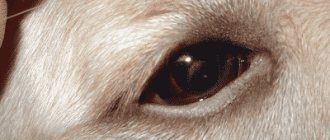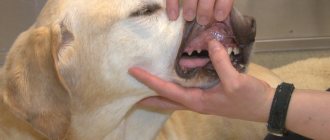Probably most of us have wondered what helps people and animals walk upright, balancing, without falling anywhere. The vestibular apparatus is responsible for maintaining the balance of the body in space. It is composed of central and peripheral structures that are localized in the brain and inner ear.
When the balance of the body is disturbed, neurological disorders appear, which are combined under the general term “vestibular syndrome”. It can appear in different forms, depending on the cause and location. Manifestations of vestibular syndrome in older dogs are very dangerous. Treatment for their condition is usually ineffective. Puppies have a better chance of recovery.
Vestibular syndrome in dogs: what is it?
This is a symptom complex that is diagnosed in dogs with pathological conditions affecting the central or peripheral nervous system. As a result of disturbances, the vestibular apparatus begins to function incorrectly.
Depending on the location of the lesion, peripheral and central forms of the disease are distinguished. Peripheral vestibular syndrome occurs when the peripheral nerves connecting the brain to the inner ear are damaged. More often in dogs there is a central form. It is more severe because it affects the central nervous system. In addition to vestibular syndrome, other pathological conditions are observed that can be very life-threatening for the animal.
Vestibular syndrome can be confused with the development of a stroke. The dog loses spatial orientation. She has an unsteady gait, reminiscent of a drunken person. From the outside it may look funny. But in fact, this is a very dangerous phenomenon that requires immediate contact with a specialist.
Treatment for impaired motor coordination in dogs
With such serious symptoms, especially if they appear after suffering any illness, it is imperative to contact a veterinary clinic and thoroughly examine the animal. You may need:
- x-ray,
- tests for bacterial and viral infections,
- tests for adrenal and thyroid hormones,
- cerebrospinal fluid analysis,
- computed tomography of the brain.
The success of treatment will largely depend on the accuracy of the diagnosis.
The vestibular system is responsible for maintaining balance. The vestibular apparatus has central structures located in the brain and peripheral structures located in the inner and middle ear.
Vestibular syndrome in dogs refers to a sudden, non-progressive imbalance. Typically found in older dogs. In older dogs, this condition is also often diagnosed as idiopathic vestibular syndrome (occurring for no apparent reason).
Causes and predisposing factors
There are several reasons that can provoke vestibular syndrome:
- inflammatory processes of the middle and inner ear;
- improper ear cleaning;
- severe head injuries;
- neoplasms, polyps;
- meningoencephalitis;
- uncontrolled use of certain medications (especially aminoglycoside antibiotics);
- disruption of hormone synthesis (for example, thiamine deficiency).
What is Horner's syndrome in dogs, how to treat the disease and why is it dangerous? Read useful information.
Photos of the Lancashire Heeler dog breed, rules for keeping, raising and training a pet can be seen in this article.
There are cases of vestibular syndrome that are congenital or occur in older dogs for no apparent reason. In such cases, the idiopathic nature of the disease is recognized. The syndrome can appear in any dog, regardless of breed and age. But according to statistics, it is more often diagnosed in beagles, Dobermans, cocker spaniels, and fox terriers.
Causes of the disease
Among veterinarians, this painful syndrome is usually divided into two types - peripheral and central, each of which depends on the location of the lesion. In addition, doctors also know such types as toxic, inflammatory, traumatic, metabolic, idiopathic and neoplastic. The name of each of them is entirely based on the etiology that led to the manifestation of the disorder. The further therapeutic scheme is based on the specialists’ identification of the harmful factor.
It is important to understand that peripheral vestibular syndrome in dogs is diagnosed quite rarely. It is provoked by damage to the animal’s nervous system caused by something, which leads to dysfunction of the inner ear.
The central form of the syndrome is diagnosed much more often and is much more difficult, since the painful process includes not only the vestibular apparatus, but also other vital systems of the dog’s body. In some cases, this can lead to disability and death.
Experts identify the following reasons on which the syndrome manifests itself:
- aggravating consequences after head injuries experienced by a dog;
- various neoplasms and polyps;
- malfunctions in the hormone production system (in particular, lack of thiamine);
- uncontrolled use of drugs containing antibiotic components by animals;
- inflammatory processes occurring in the inner and middle ear of a shaggy friend;
- meningoencephalitis;
- excessive use of dog ear cleaners by the owner.
Pathology of the idiopathic type can be congenital or occur as a result of the aging of the pet’s body. That is, it is provoked for no particular reason, which significantly complicates the effectiveness of its treatment. The disease is diagnosed in both puppies and adults. Breeds such as German Shepherd, Beagle, Cocker Spaniel and Doberman are particularly vulnerable to it.
Signs and symptoms
Often, manifestations of the syndrome can be mistaken for a stroke. The main sign of pathology is loss of coordination in space. It is difficult for the dog to move, it walks with its head bowed, stumbles, and spins around itself. Some owners perceive this behavior as an attempt to play, and are in no hurry to take the dog to the veterinarian. This could cost her not only her health, but also her life.
Other symptoms of vestibular syndrome:
- vertical nystagmus (eye twitching);
- profuse drooling;
- uncontrollable vomiting;
- dizziness;
- poor response to voice;
- paralysis of the facial muscles is possible.
In severe cases, the animal refuses to eat and empties itself.
What is ataxia
Contrary to popular belief, ataxia is not the name of a specific disease, but only denotes a list of characteristic symptoms of an animal’s illness, which in turn may turn out to be manifestations of a serious illness.
In general, ataxia is expressed in:
- the appearance of trembling in the limbs, preventing the animal from standing on its paws (the pet often sits down or lies down);
- sudden loss of coordination when running or walking (the animal may suddenly throw to the side);
- an animal falling for no reason;
- violation of certain actions (a sick dog cannot always sit or stand as before).
Based on the root cause of the disorder, it is customary to distinguish vestibular, sensitive and cerebellar ataxia. Each species has its own characteristics and reasons for development. Thus, the vestibular variant indicates disturbances in the functioning of the vestibular system, which helps the animal maintain balance in space. At the slightest undesirable impact on it, the animal will not even be able to hold its head in the desired position, not to mention circling in one place or constantly falling with skidding of the body.
An additional symptom of vestibular ataxia in some cases is uncoordinated eye movement, with a constant feeling of drowsiness, and sometimes the pet falls into a state of stupor. Sensitive ataxia is usually caused by damage to the Gaulle and Burdach bundles, although damage to another part of the spinal cord is possible. The main characteristic symptom of this species is a sharp disturbance in walking, during which the dog constantly looks under its paws. In especially severe forms of the disease, the animal cannot sit or stand at all.
Important! Vestibular and sensitive ataxia do not affect the behavior of the animal in any way and do not cause any mental abnormalities. This makes it possible to separate this pathology from dangerous infectious diseases.
As for the less common cerebellar type of ataxia, its root cause is considered to be damage to an area of the brain called the cerebellum. It is responsible for your pet's coordination and movement, so any damage to this area will result in a loss of coordination, balance, and overall motor control. In especially severe forms, the sick animal may not recognize its owners or its place of residence. Common causes of damage to the cerebellum include brain tumors, infection, or birth defects (extremely rare, since both parents must be carriers of the recessive gene).
Diagnostics
To make a correct diagnosis, a whole range of studies is required. After all, vestibular syndrome is not a separate disease, but a manifestation of various pathological disorders in the central or peripheral nervous system.
The doctor examines the animal and collects a complete medical history. Additionally assigned:
- general blood and urine analysis;
- x-ray of the middle and inner ear;
- MRI, CT scan of the brain;
- scraping from the ear;
- Ultrasound of internal organs;
- tests to determine the nervous system's response to stimuli.
Treatment methods
If a dog has congenital vestibular syndrome or it developed in an elderly dog (idiopathic form), then treatment in such cases is ineffective. The doctor can only prescribe medications to alleviate the condition and relieve some syndromes. If the pet becomes helpless, the owner will have to constantly look after it, turn it over, and massage it to avoid bedsores.
The syndrome, which developed against the background of inflammatory and infectious processes, requires the use of broad-spectrum antibiotics and anti-inflammatory drugs. In severe cases, corticosteroids (Prednisolone) are prescribed. If otitis is detected, it is prohibited to give the animal ototoxic drugs from the group of aminoglycosides, Chlorhexidine.
On a note! If the pathological condition arose as a result of a malignant formation, it can only be eliminated surgically.
For hormonal disorders, replacement therapy is usually carried out.
Therapy
Let us immediately warn you that treatment of vestibular syndrome in dogs is impossible if we are talking about a congenital case, or when the disease begins to develop in an old dog. In this case, only drugs are prescribed that alleviate the animal’s condition. Of course, in cases where the dog becomes helpless, the owner will have to constantly care for it, remove secretions, and massage it in order to avoid the development of bedsores.
There is good news: if vestibular syndrome appears in a very young puppy, there is a good chance that its vestibular apparatus will fully adapt to unusual conditions, after which the animal will be able to live a full life. In principle, even in old dogs it is most often possible to induce remission, but the dog may still have the “habit” of walking with his head bowed.
Since in most cases the disease is caused by inflammation of an infectious etiology, broad-spectrum antibiotics are prescribed, cancer is treated surgically (if possible), or through chemotherapy. In situations where hypothyroidism has led to the development of the disease, replacement therapy is resorted to.
As a rule, if the root cause is completely eliminated, it is possible to completely get rid of vestibular syndrome. Unfortunately, this applies to a lesser extent in cases of oncology: even if a malignant tumor is removed, the animal may suffer from residual effects.
Complications and prognosis
Vestibular symptoms are most severe in the first 1-2 days. With timely treatment, stabilization of the condition is observed after 3 days. After 1-2 weeks, head ataxia improves. In 2-3 weeks the dog can fully recover. But it would be incorrect to talk about a complete cure.
As for the prognosis, they can be positive if the syndrome was diagnosed in puppies and it is not congenital. It all depends on how serious the root cause of the pathology was. If it can be completely eliminated, then a positive prognosis can be expected. If cancer is detected in a dog, the animal will have to suffer from residual effects for the rest of its life; recovery in such cases is unlikely.
What should you do if your dog becomes lethargic and doesn’t eat well? Learn about the likely causes and solutions.
How and how to treat resolving osteochondrosis of the elbows in dogs? Effective treatment options are collected in this article.
Go here to read about the signs, symptoms and treatment of third eyelid inflammation in dogs.
Causes of the disease
Among veterinarians, this painful syndrome is usually divided into two types - peripheral and central, each of which depends on the location of the lesion. In addition, doctors also know such types as toxic, inflammatory, traumatic, metabolic, idiopathic and neoplastic. The name of each of them is entirely based on the etiology that led to the manifestation of the disorder. The further therapeutic scheme is based on the specialists’ identification of the harmful factor.
It is important to understand that peripheral vestibular syndrome in dogs is diagnosed quite rarely. It is provoked by damage to the animal’s nervous system caused by something, which leads to dysfunction of the inner ear.
The central form of the syndrome is diagnosed much more often and is much more difficult, since the painful process includes not only the vestibular apparatus, but also other vital systems of the dog’s body. In some cases, this can lead to disability and death.
Experts identify the following reasons on which the syndrome manifests itself:
- aggravating consequences after head injuries experienced by a dog;
- various neoplasms and polyps;
- malfunctions in the hormone production system (in particular, lack of thiamine);
- uncontrolled use of drugs containing antibiotic components by animals;
- inflammatory processes occurring in the inner and middle ear of a shaggy friend;
- meningoencephalitis;
- excessive use of dog ear cleaners by the owner.
Pathology of the idiopathic type can be congenital or occur as a result of the aging of the pet’s body. That is, it is provoked for no particular reason, which significantly complicates the effectiveness of its treatment. The disease is diagnosed in both puppies and adults. Breeds such as German Shepherd, Beagle, Cocker Spaniel and Doberman are particularly vulnerable to it.











